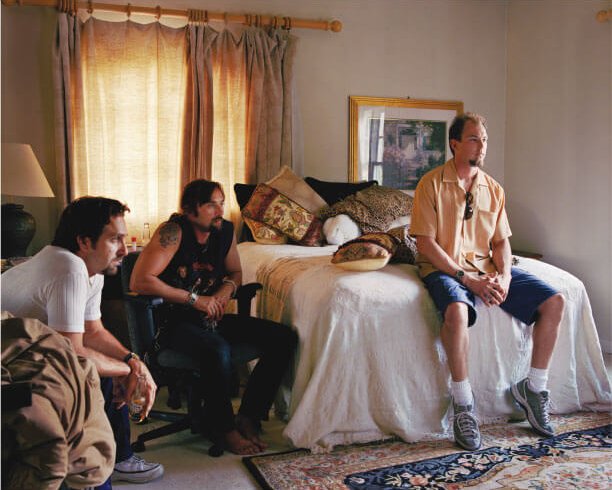In 2003, porn actor Ron Jeremy set out on a tour of American college campuses. At every stop the veteran of more than 1,800 hard-core films was greeted by fans, many of them teenagers. Few who clamoured to see Jeremy had likely rented his 1988 movie 21 Hump Street or 1996’s Another White Trash Whore. They probably knew him instead through the reality-TV show The Surreal Life and documentary film Porn Star: The Legend of Ron Jeremy, as well as his cameos in Hollywood films like The Rules of Attraction and Boogie Nights. At the University of Alabama Jeremy participated in one of a series of debates with the Canadian writer and anti-porn activist Susan G. Cole. As reported in Pamela Paul’s Pornified, students in attendance, some wearing “I love porn” T-shirts, cheered Jeremy’s boasts about the benefits of pornography and “having a party” while booing Cole for her objections. “What’s your fucking problem?” one young scholar asked Cole during the question period.
Pornography, it is worth remembering, peeled off its brown-paper wrapping only quite recently. The way it struts through popular culture these days, waving various small flags of faux liberation and a much larger banner bearing a simple dollar sign, you might think it had gone mainstream back in the 1960s, along with the pill. In fact, the porn parade down the boulevards of North American life is about a decade old, and many middle-aged watchers, unschooled in sex.com or Britney Spears, still may not be sure what those raunchy floats and teenaged pole dancers represent. Younger observers, having grown up inside the Internet, and anyone attempting to raise children in the early twenty-first century know all too well.
The clever industry fluttering of those lesser flags — pornography as sexual liberation, as third-wave feminist assertion, as freedom-of-expression battleground — in the faces of concern seemed to temporarily stifle criticism. But today, for a pioneering group of commentators and novelists, the wish is to remark not on the spectrum of porn that reflects a liberated relationship with sex, but those activities that are symptomatic of a distorted and even abusive vision of human sexuality. Distinguishing the exhibitionist tendencies of giggly college girls from, say, dubiously consensual incest web-sites out of eastern Europe ought to be easy enough. But extreme porn, especially the degraded forms that flourish in cyberspace, invites both conflations and a tendency to moralize.
Moral objections, however, more than legal or aesthetic ones, may be the most instinctive response to what Martin Amis calls “the obscenification of everyday life.” Harm, observers assert, is being done here. Harm to those watching extreme porn and harm to those being watched. Harm as well to community standards, especially those concerning young people, who still deserve our protection and guidance. Finally, harm is being done to all our fragile sexual selves, which may be incapable of withstanding the relentless assaults of a multi-billion dollar industry whose principal effect is to make a mess of our relationships.
Ariel Levy began noticing the change several years ago. The author of Female Chauvinist Pigs would switch on her television to find “strippers in pasties explaining how best to lap dance a man to orgasm.” Viewing the film Charlie’s Angels, a hit in the summer of 2000, she would contrast the assertions of its stars that they were presenting strong women with the visual evidence of the actresses dressing on screen in “alternating soft-porn styles.” On the newsstands were fresh examples of the “porny new genre” dubbed the “lad magazine.” Publications such as Maxim, FHM, and Stuff fixated on “greased celebrities in little scraps of fabric humping the floor.”
Equally, the thirty-one-year-old New York journalist, whose mother attended weekly women’s consciousness-raising groups and didn’t own any makeup, was observing teenaged girls walking the streets in jeans that exposed their “butt cleavage” and tops showing “breast implants and pierced navels alike.” Those women were, moreover, cheerfully stripping for the Girls Gone Wild videos, going to strip clubs, and buying the memoirs of porn stars Jenna Jameson and Traci Lords, which both graced the New York Times bestseller list. “When I was in porn,” Lords admitted in 2003, “it was like a back-alley thing. Now it’s everywhere.” How, Levy wanted to learn, had the “tawdry, tarty, cartoon-like version of female sexuality” of a Pamela Anderson or Paris Hilton come to be ubiquitous and promoted as progress for women in a post-feminist world? “Because we have determined that all empowered women must be overtly and publicly sexual,” she writes, “and because the only sign of sexuality we seem able to recognize is a direct allusion to red-light entertainment, we have laced the sleazy energy and aesthetic of a topless club or a Penthouse shoot throughout our entire culture.” Barbara Walters interviewed Hilton for her television special The Ten Most Fascinating People of 2004.
“Raunch culture,” as Levy calls it, may be hardest on adolescent girls. Blitzed with images of how to be “hot,” young women, already prone to insecurities, have a difficult time distinguishing the fake from the real. Their mothers, at least, could summon an era when the politics of feminism were ascendant. Not so for their new-millennium daughters. “They have never known a time when ‘ho’ wasn’t part of the lexicon,” Levy contends, “when sixteen-year-olds didn’t get breast implants.” Nor do most teens yet possess the sense of irony needed to negotiate a cynical, commerce-driven pop culture. This is their reality, and too often they accept it at its false-face value.
If Female Chauvinist Pigs offers a PG-13 critique of the mainstreaming of pornography, Pornified heads with grim determination for the xxx shelves — or, better, the websites. “Porn Inc.,” Pamela Paul points out, evolved from a multi-million dollar business in 1975, flashing its wares in selected grotty movie houses around the United States, into what is currently a multi-billion dollar international industry. While a few porn palaces still blink their come-ons and all but a fraction of the pay-per-view movie sales in hotels are “adult” in content, and while Americans spent upwards of $4 billion on video pornography for home use, the digital proliferation of porn on the Internet is where the colossal profits are being made. In Paul’s view, Internet porn is also where the lasting damage is being done.
“Old school defenders of pornography,” she writes, “may not be familiar with the direction in which Internet and dvd-era pornography has gone.” When an entertainment analyst is asked to define “acceptable adult programming” for specialty cable TV, his list includes penetration, oral, anal, and group sex, along with lesbian and gay sex. Such material, the analyst admits, “used to be called pornography, but a lot of that has become socially acceptable now.” What is pornographic these days? The bar, needless to say, especially in cyber-porn, has nowhere to go but up. “Pregnant women become pornified,” Paul reports, “their naked torsos wrested from personal Web sites onto ‘pregnant porn’ Web sites, incest becomes fetishized, child pornography blends with adult pornography into an ageless ‘teen porn’ middle ground. Any sense of taboo dissipates in a free-for-all porn world.”
Much of Pornified is devoted to cyber-porn addiction. Paul’s broad focus is on men and boys, by far the biggest junkies. Interviewing American males with names like Harrison, Gabe, and Ian, she learns how obsessive cruising on the Internet wreaks havoc on their conceptions of women and sexuality. They become impatient with their real-life partners and grow numb to the pleasures of conventional sex. “Pornography leaves men desensitized to both outrage and to excitement,” Paul writes, leading to dissatisfaction with the emotional tugs of their own lives. By definition, addicts crave more junk. With cyber-porn those cravings encourage greater expansion of the global “pornotopia”: more gonzo group-sex sites from Russia, wilder teen stuff from Japan. Addiction, Pornified contends, leads cyber-viewers to extreme forms of sexual debasement, which in turn deepens the addiction.
For all its moral outrage, Pornified advocates a tempered “censure-not-censor” response, the aim being to move society away from viewing pornography as “hip and fun and sexy” and toward recognizing it as “harmful, pathetic, and decidedly unsexy.” Here, one suspects, is the Rubicon none of us should seek to cross. What cyber-porn permits isn’t so much boundless tawdry choice and glum stimulation as too effortless an absolution from the reality of what is being observed. Flickering across a million monitors in a hundred countries at this very moment are not tales taken from Debbie Does Dallas or Another White Trash Whore, but images of women and men most of whom are performing lewd sexual acts before a camera because they are poor, damaged, or have been coerced into doing so. It shouldn’t be so easy to ignore this while pleasing ourselves.
Pamela Paul does not include sex-industry workers in her survey, and Ariel Levy refers to them only briefly, noting as a “clich_ that bears repeating” that most women who make sex films were themselves the victims of sexual abuse. Based on conversations with experts, and too freely lumping prostitutes with porn actresses of all schools, she puts the figure at between 65 and 90 percent. She also cites a 1998 study titled “Prostitution in Five Countries: Violence and Post-Traumatic Stress Disorder.” It concludes that two-thirds of prostitutes suffer from symptoms identical to those of post-traumatic stress disorder — twice the percentage as of American soldiers returning from the war in Vietnam. “There is something twisted about using a predominantly sexually traumatized group of people as our erotic role models,” she writes, thinking perhaps of Jenna Jameson, whose book, How to Make Love Like a Porn Star, details her being gang-raped in high school and sexually assaulted as an adult. “It’s like using a bunch of shark attack victims as our lifeguards.”
In two recent novels, the identity of those shark victims varies according to generational conceptions of how pornography does its damage. Margaret Atwood’s Oryx and Crake offers a traditional portrait of abuse. Porn has supplanted intimacy in the novel’s devastated near-future setting. “Executions were its tragedies,” Atwood writes of this world, “pornography was its romance.” Oryx, first sighted by her would-be lover on a kiddie-porn site, is abused starting at a young age, and her eerily flat recounting of the experience is definitely a clich_ that bears repeating: “Whatever it was, you had to do it, and you did it because you were afraid not to. You did what they told you to do to the men who came, and then sometimes those men did things to you. That was movies.”
“It wasn’t real sex, was it?” her friend asks, clinging to the illusion that maybe no harm is done during these encounters. “It was only acting. Wasn’t it?” To this, Oryx replies: “But Jimmy, you should know. All sex is real.”
Britain’s Helen Walsh’s debut novel, Brass, posits a complex new kind of victim. Millie O’Reilley is a bright but jaded Liverpool university student whose impulses are those of a “female chauvinist pig.” The opening scene alone, where Millie pays for rough lesbian sex with a teen prostitute in a graveyard, is both scandalous and revelatory. This young woman, raised by a professor father in the 1990s, is no more sensitive than the most brutish male. “I manipulate myself hard and selfishly,” she says of the encounter, “the whore becoming nothing but a body. A cunt in a magazine.” Millie admits that she, too, sees females as objects rather than as humans; she sees them “through the eyes of a pornographer.” Though Walsh, who is just twenty-eight, isn’t explicit, her character is offered as both victimizer and victim — a distinctly twenty-first-century casualty of porn.
To some, Martin Amis’s Yellow Dog is itself pornographic. The novel is a calculated howl, and its narrative strategies — various parallel forays into the vast dark cave of what its author elsewhere dubs “the near-infinite chaos of human desire” — are a challenge to follow. But Amis’s point is as clear as his methods are murky. Men, the novel suggests, have enormous trouble maintaining sexual balance in their heads and hearts, and the mainstreaming of porn is proving a disaster for this uneasy equilibrium, making “yellow dogs” out of many males and victims out of many women and children.
Mercifully, it is still men’s thoughts, more than their actions, which stumble about in the cave. A father who has suffered a “de-enlightenment” due to a violent assault starts to fantasize about his daughters. (“They’re mine, and I can’t protect them. So why not rend them? Why not rape them?”) A scurrilous journalist wonders about his failures at relationships. (“Each night, as he entered the Borgesian metropolis of electronic pornography — with its infinities, its immortalities — Clint was, in a sense, travelling towards women. But he was also travelling away from them.”) Imagine what would happen, Yellow Dog contends, if such thoughts were let loose as actual acts committed upon actual people. “We get over it,” a porn actress says of the abuse she suffered in childhood. “No you don’t,” she is corrected. “No we don’t,” she concedes. “Obviously.”
There is no end to the obvious damage on parade in extreme pornography, should one wish to acknowledge it. Nor is that extremity difficult to find, thanks largely to the Internet. But even if one grants that a pornographic sensibility has gained a degree of mainstream acceptance in society, is there actual evidence of a slippery slope of collective harm? When the Supreme Court of Canada ruled in favour of legalizing sex clubs in December, it declared that there was no sign that “the sexual conduct at issue harmed individuals or society.” Dissenters to the ruling, including the editorial writers of the Globe and Mail, argued back that the courts should be used to discourage activities that “offend community standards.” The paper also decided that waiting until there is a clear indication that indecency is sliding into depravity is waiting, in effect, until it is too late. But a consensus about “community standards” may no longer be available. Sex remains a moral issue for most adults, but not in the way it once was. The movement has been away from the morality of sex itself — no pre-marital sex, the proscription of homosexuality — to the issue of harm: people shouldn’t be getting off on the acts of those who are themselves traumatized and are being traumatized by what they are doing. Maybe terms like “obscene” and “pornographic” have lost their nuance. Words such as “dangerous” and “humanly disastrous” might be more to the point.
In an essay about the porn industry in California, Martin Amis wrote that “porno is littered — porno is heaped—with the deaths of feelings.” To be more specific, in its exploitation of personal tragedy and naivete, its misrepresentation of human erotica, especially among newly sexualized youths, who may never recover from being consumers of its distortions, in its indifference to consequence, to the causality of action and effect, both on screen and in real life, extreme pornography may be stalking one emotion more than any other. That would be the shared feelings we have for fellow humans, along with the inclination to recognize kindred suffering and even lend aid. Porn may yet be the death of empathy.









